Altitude sickness in Nepal occurs when a traveler continuously gains elevation without proper acclimatization. It results from thin air, i.e., low oxygen levels in the air.
In Nepal, high-altitude sickness is common for first-time hikers going on high-altitude treks such as the EBC Trek. Whether you are trekking in the Manaslu Circuit, Everest, Kanchenjunga, Dhaulagiri, or other regions, you travel to two altitude regions aptly known as “High altitude” and “Very high altitude.”
Some begin experiencing mild altitude sickness while trekking above 2750 m, i.e., high altitude. But most travelers experience severe high-altitude sickness when trekking above 3500 m of elevation.
As the pressure of oxygen above 2500 m decreases over time, rapidly ascending the elevation can cause serious symptoms, which can be fatal. Acute Mountain Sickness (AMS) can occur in the beginning. If not taken care of and you keep on taking excessive elevation, it can lead to water retention in the brain, i.e., High Altitude Cerebral Edema (HACE), or water retention in the lungs, i.e., High Altitude Pulmonary Edema (HAPE).
Thus, this Altitude Sickness Guide will help you identify high altitude sickness, deal with the symptoms, and also provide immediate treatment. Also, we will talk about preventative measures for altitude sickness while trekking in Nepal.
Table of Contents
- Acute Mountain Sickness (AMS) in Nepal
- Severe Complications
- How to Prevent Altitude Sickness While Trekking in Nepal?
- FAQ about Altitude Sickness in Nepal
- What Causes Altitude Sickness?
- What does high altitude illness do to your body?
- Am I likely to get altitude sickness on my Everest Base Camp Trek?
- What are some high-altitude treks where I am likely to experience altitude sickness?
- Do healthy people get altitude sickness in Nepal?
- Is it hard to breathe because of altitude illness?
- Can I prevent altitude sickness naturally without taking medications?
Acute Mountain Sickness (AMS) in Nepal
Altitude sickness is also known as acute mountain sickness (AMS) or altitude illness in Nepal. The symptoms of altitude sickness occur on every tour of Nepal at elevations higher than 4,000 meters. However, mild symptoms may appear between 6-12 hours after reaching 2,750 m or above.
Symptoms of Altitude Sickness
- Headaches
- Being tired and lazy,
- Dislike eating.
- Nausea and vomiting,
- body tingling
- Dizziness
- Upon exertion, shortness of breath,
- Bleeding from the nose
Symptoms of high altitude sickness while trekking in Nepal may vary depending on the following factors:
- A person’s pace of gaining altitude,
- amount of time in a higher region,
- Age,
- Weight,
- Blood pressure,
- Respiratory capacity,
- Experience with the thin air.
Treatments for altitude sickness in Nepal:
- After you see some symptoms of AMS, stop going to higher altitudes and rest for half an hour.
- Don’t forget to drink plenty of water and other liquids, as it keeps your body hydrated.
- If you have severe symptoms of altitude sickness while trekking, use a Gamow bag if possible. (A Gamow bag is a bag that wraps up a person and helps increase atmospheric pressure around them. Mountaineers mostly use it.)
- If you have excessive pain, take acetaminophen such as Tylenol, or another painkiller like Ibuprofen 500 mg.
- Take altitude sickness medicine, Acetazolamide, 250 mg twice a day. It speeds up the person’s breathing rate.
If the health of the patient with altitude sickness does not improve within 24 hours or if their health condition worsens, the patient should be carried 500 m or 1000 m down to the lower altitude. And you can start trekking again when your body adapts.
Severe Complications
If you gradually keep on climbing higher, you may develop severe complications of altitude sickness. In such cases, acute mountain sickness (AMS) will worsen to severe high altitude pulmonary edema (HAPE) or high-altitude cerebral edema (HACE). Some symptoms of severe complications of altitude sickness include blurred vision, tight chest, fainting, fever, persistent cough with pinkish sputum, etc.
Although trekking does not involve such cases, altitude sickness should be taken care of while visiting high altitudes in Nepal.
How to Prevent Altitude Sickness While Trekking in Nepal?
- Ascend slowly. After you reach 3000 and after every 1000 m above, rest for a day for environmental change. Otherwise, get down around 300-400 m to sleep from the highest point you reached that day.
- Drink plenty of fluids, like water.
- Eat Carbs. It means your body needs extra energy at high altitudes, so eat extra carbohydrates while trekking.
- When going to high altitudes, increase the altitude slowly (above 2750 m).
- Even if you climb to greater heights during the day, come down to at least 300-400 m to sleep for the night.
- Special care should be taken if there is a person with altitude sickness.
- If you experience a leak, even if you do not improve your health while resting, immediately call 911.
- Smoking, alcohol, and sleeping pills should not be taken.
- Don’t do heavy exercises at high altitudes.
- Remember not to climb the heights alone and inform your trekking guide or a trusted person if you suspect something is awkward and leaky.
- Take Acetazolamide 250 mg twice a day to prevent high altitude sickness.
- Ascend 1000 m in one day. Do not climb higher than that.
How important is acclimatization to prevent altitude sickness?
Acclimatization in Nepal refers to taking rest at the same altitude for a few hours or an extra day or two. As you gradually walk towards the higher regions, your body needs time to adapt to the changing environment. The amount of oxygen in the air decreases with an increase in altitude, so your body starts responding differently, but it takes time. Hence, acclimatization is very important while trekking in the high altitudes of Nepal.
With each meter of elevation gain, everyone reacts differently. The effect also changes according to age, fitness level, and experience. As we climb higher, the distance between each oxygen molecule increases, causing air pressure to drop. This is referred to as “thin air.” Our body can adjust itself to some extent as the air becomes thinner and thinner.
Because of thin air, our breathing rate first increases. Then our body will start producing more red blood cells, which are the primary carriers of oxygen, from the lungs to other parts of the body. In time, the capacity of the lungs also increases. Finally, our body also produces a special enzyme that speeds up transferring oxygen to the tissues. Acclimatization is essential for these processes, and our bodies require extra time for all of them.
However, if you are a sherpa living in the mountains or an experienced high-altitude trekker, your body will be well accustomed to the low oxygen. But, for others, it takes time. So, before attempting high-altitude treks in Nepal, it is better to try beginner hikes so that you experience altitude sickness.
Walking at a fast pace or taking continuous elevations is one of the major causes of high altitude sickness. That is why acclimatization is very important while taking Himalayan treks.
FAQ about Altitude Sickness in Nepal
What Causes Altitude Sickness?
The primary cause of altitude sickness while trekking in Nepal is ascending to a great height too fast. The number of oxygen molecules decreases with an increase in height. So, our bodies take time to cope with the change. If it doesn’t get enough time to adapt to the new environment, it shows symptoms of altitude sickness.
What does high altitude illness do to your body?
The mild symptoms of altitude sickness cause little harm to your body. But, if ignored and continued on the journey, it may turn severe. High altitudes speed up your breathing rate, increase the capacity of your lungs, and generate more red blood cells in your body. But, it takes time.
Am I likely to get altitude sickness on my Everest Base Camp Trek?
Yes, altitude sickness can be felt starting at a height of 2750 m. However, the starting line for altitude sickness depends upon various factors, including a person’s age, blood pressure, fitness level, experience, etc. Lukla is the starting point of the EBC Trek package, which is at a height of 2860 meters. As a result, first-time hikers or the elderly may experience symptoms from the Lukla itself.
After Lukla, we head to Phakding to spend the night and trek to Namche the next day. Here, the height of Namche Bazaar is 3500 m. So, trekkers are required to have an acclimatization day in Namche to prevent altitude sickness. On the rest day, we hike to the Everest View hotel and come back to Namche to sleep. This way, our bodies will have enough time to adapt to a changing environment. If you do not take an acclimatization day in Namche, you are likely to develop the symptoms of altitude sickness unless you are a very experienced trekker, sherpa, or mountaineer.
After Namche, you should have a rest day in Dingboche. The village is at a height of 4410 m. So, today, we hike to nearby Nagerjun hill and return to Dingboche to sleep. If you develop symptoms at other points of the Everest Base Camp Trekking, take rest days or acclimatization days in between, or else two acclimatization days are fine.
What are some high-altitude treks where I am likely to experience altitude sickness?
Some of the challenging treks in Nepal include the Everest Three Passes Trek, Everest Base Camp Trek, Gokyo Lake Trekking, Manaslu Circuit Trek, Dhaulagiri Base Camp Trek, Nar Phu Valley Trek, Upper Dolpa Trek, Annapurna Circuit Trek, Annapurna Base Camp Trek, Kanchenjunga Base Camp Trek, etc. With all these trekking packages, you hike to an elevation of over 4000 m, so altitude sickness should be taken care of. Heaven Himalaya will have a trained guide to deal with altitude sickness, but also, being prepared beforehand is one of the first traveling tips in Nepal.
Do healthy people get altitude sickness in Nepal?
Yes, if you are healthy but do not have experience walking in high altitudes, you can get altitude sickness while trekking.
Is it hard to breathe because of altitude illness?
Yes, one major symptom of severe illness is shortness of breath. If you feel so, stop at a place for a few hours or get down to a lower height. Don’t forget to explain it to your trekking guide. He will have experience dealing with such cases.
Can I prevent altitude sickness naturally without taking medications?
Yes, you can prevent altitude illness naturally by taking plenty of water, trekking at a slow pace, including acclimatization days in your itinerary, eating more carbs, and many more.

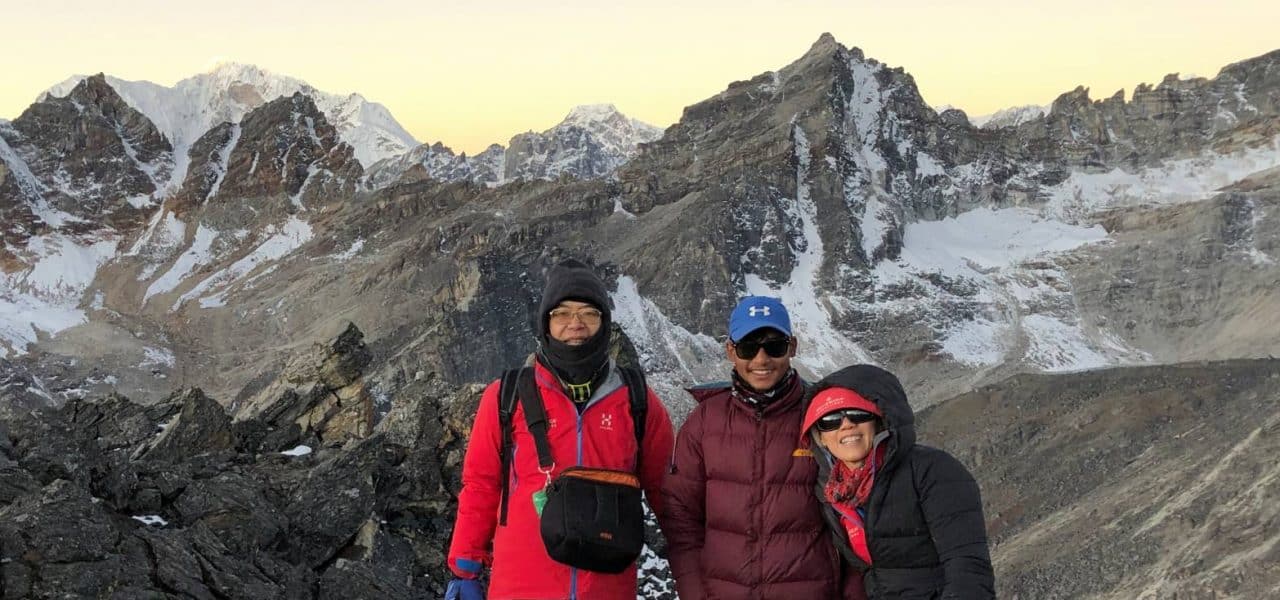

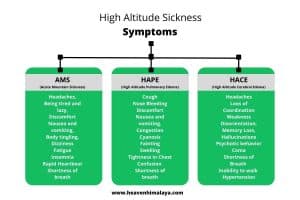

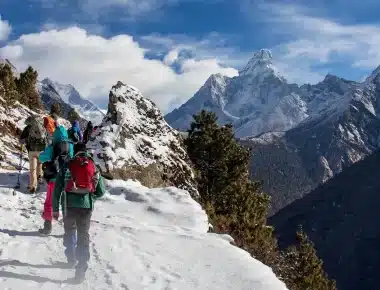
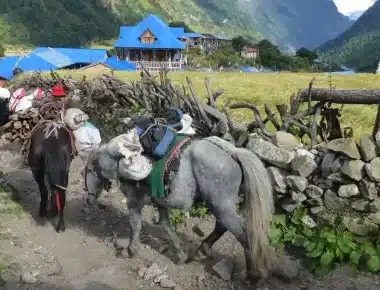
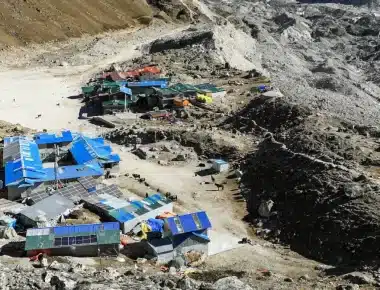
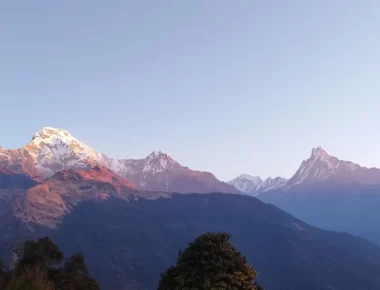

[…] most important advice is to have fun and take your time. Altitude sickness is very serious and can get you. When arriving at your destination each day, climb higher to help […]
[…] of altitude sickness. Mild illness is common for trekkers above 3000 m. Hence, read about the symptoms, complications, and medications of altitude sickness […]